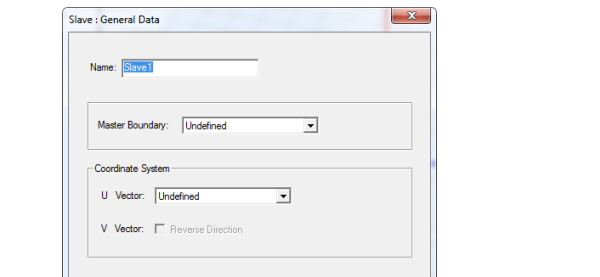- HFSS15在線幫助
- 首頁
- HFSS教學
- HFSS 15 在線幫助文檔
Assigning Boundaries
Assigning Slave Boundaries
Master and slave boundaries enable you to model planes of periodicity where the E-field at every point on the slave boundary surface is forced to match the E-field at every corresponding point on the master boundary surface to within a phase difference. The transformation used to map the E-field from the master to the slave is determined by specifying a coordinate system on both the master and slave boundaries.
To assign a Slave boundary:
1. Select a surface on which to assign the boundary and click HFSS>Boundaries>Assign>Slave to bring up the Slave Boundary dialog box.

2. Select the corresponding master boundary from the Master Boundary pull-down list.
If a master boundary has not yet been defined, return to make this selection when it has been defined.
3. You must specify the coordinate system in the plane on which the boundary exists. First draw the U vector of the coordinate system. HFSS uses the U vector that you draw and the normal vector of the boundary face to calculate the Vvector. If necessary, you can reverse the direction of the V vector.
a. Select New Vector from the U Vector pull-down list.
The Slave Boundary dialog box disappears while you draw the U vector.
b. Select the U vector’s origin, which must be on the boundary’s surface, in one of the following ways:
• Click the point for the vector origin.
• Type the point’s coordinates in the X, Y, and Z boxes.
c. Select a point on the u-axis to indicate the U vector direction.
The Slave Boundary dialog box reappears and the model display shows the U vector and V vector as red and blue arrows respectively.
d. If you need to reverse the direction of the V vector, select Reverse Direction.
4. Click Next.
5. You have the option to relate the slave boundary’s E-fields to the master boundary’s E-fields in one of the following ways:
• For driven designs, select Use Scan Angles to Calculate Phase Delay to enable the Scan Angle fields. Then enter Phi and Theta scan angles. These apply to whole model, in the global coordinate system. The phase delay is calculated from the scan angles; however, if you know the phase delay, you may enter it directly in the Phase Delay box below.
Note |
For Eigenmode problems, the Use Scan Angles to Calculate Phase Delay fields are disabled. |
• Select Field Radiation, and then enter the phase difference, or phase delay, between the boundaries’ E-fields in the Phase Delay box. The phase delay applies only to this boundary.
Note |
You can assign a variable as the phi, theta, or phase delay values. |
HFSS will compute the E-field on the master boundary and map it to this boundary using the transformation defined by the master and slave coordinate systems.
Related Topics
Technical Notes: Master and Slave Boundaries
Assigning Master Boundaries
Getting Started Guides: Floquet Ports
-

國內最全面的HFSS培訓課程,包含7套視頻教程和2本教材,資深專家講解,視頻操作演示,結合最新工程案例,讓HFSS學習不再難...【詳細介紹】





